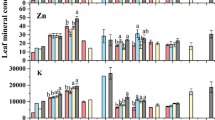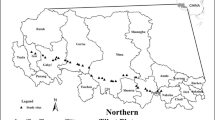Abstract
The ability of different alpine species to influence soil nutrient concentrations was quantified by growing monocultures of 17 species on a homogenized acid alpine soil mixture. The experiment was carried out at 2750 m a.s.l. in the Teberda Reserve, Northwest Caucasus. Soil nuturient contents (NH4, NO3, P, Ca, Mg, and K) and pH were analyzed after 6 years. The same soil mixture but without plants was used as a control. The plant species had significant effects on all soil properties. Different species groups tended to decrease different nutrients to different extents, e.g.Matricaria caucasica had the lowest level for NO3 andFestuca ovina for P. Many species increased the cation content (Ca, Mg, K) in the soil in comparison with the control. Prevention of cation leaching seems to be the main mechanism of these increases, because initial cation contents were higher than the final. All species, exceptSibbaldia procumbens, increased soil pH in comparison with the final control. Significant differences among taxonomic groups (families) were found for exchangeable Ca, Mg, and pH.Fabaceae decreased cation contents (Ca, Mg), but tended to increase nitrogen (NH4, NO3).Cyperaceae (Carex spp.) tended to decrease ammonium content, and bothAsteraceae andCyperaceae tended to decrease nitrate concentrations. The phosphorus content tended to be reduced by grasses. There was no strong correspondence between properties of native soils of 4 alpine communities and nutrient concentrations for species preferring those communities.
Similar content being viewed by others
References
Angers D.A. &Caron J. (1998): Plant-induced changes in soil structure: processes and feedbacks.Biogeochemistry 42: 55–72.
Baikalova A.S. &Onipchenko V.G. (1988): Mikosimbiotrofizm alpiiskikh rastenii Teberdinskogo zapovednika (Mycosymbiotrophism of alpine species in the Teberda Reserve). In:Onipchenko V.G. &Petelin D.A. (eds.),Opyt issledovaniya rastitel’nikh soobshestv v zapovednikakh (Investigations of plant communities in nature reserves), CNIL Glavokhoty RSFSR, Moskva, pp. 93–107.
Berendse F. (1998): Effects of dominant plant species on soils during succession in nutrient-poor ecosystems.Biogeochemistry 42: 73–88.
Bormann F.H. &Likens G.E. (1979):Pattern and process in a forest ecosystem. Springer, New York.
Bowman W.D., Schardt J.C. &Schmidt S.K. (1996): Symbiotic N2-fixation in alpine tundra: ecosystem input and variation in fixation rates among communities.Oecologia 108: 345–350.
Carr D.J., Carr S.G.M. &Papst W.R. (1980): Field studies of nitrogen fixation of Australian alpine plants and soils.Austral. J. Ecol. 5: 211–220.
De Graaf M.C.C., Bobbink R., Roelofs J.G.M. &Verbeek P.J.M. (1998): Differential effects of ammonium and nitrate on three heathland species.Pl. Ecol. 135: 185–196.
Gigon A. (1999): Positive Interaktionen in einem alpinen Blumenpolster.Ber. Reinhold-Tüxen-Ges. 11: 321–330.
Grime J.P. (1979):Plant strategies and vegetation processes. J. Wiley and Sons, Chichester.
Grishina L.A., Onipchenko V.G., Makarov M.I. &Vanyasin V.A. (1993): Changes in properties of mountain-meadow alpine soils of the northwestern Caucasus under different ecological conditions.Eurasian Soil Sci. 25: 1–12.
Hobbie S.E. (1992): Effects of plant species on nutrient cycling.Trends Ecol. Evol. 7: 336–339.
Kelly E.F., Chadwick O.A. &Hilinski T.E. (1998): The effect of plants on mineral weathering.Biogeochemistry 42: 21–53.
Leishman M.R. (1999): How well do plant traits correlate with establishment ability? Evidence from a study of 16 calcareous grassland species.New Phytol. 141: 487–496.
Nye P.H. (1981): Changes in pH across the rhizosphere induced by roots.Pl. & Soil 61: 7–26.
Onipchenko V.G. (1985): Struktura, fitomassa i produktivnost’ al’piiskikh lishainikovykh pustoshei (The structure, phytomass and production of alpine lichen heaths).Byull. Moskovsk. Obshch. Isp. Prir. Otd. Biol. 90(1): 59–66.
Onipchenko V.G. (1990): Fitomassa alpiiskikh soobshestv severo-zapadnogo Kavkaza (Phytomass of the alpine communities in the Northwestern Caucasus).Byull. Moskovsk. Obshch. Isp. Prir. Otd. Biol. 95(6): 52–62.
Onipchenko V.G. (1994): Study area and general description of the investigated communities. In:Onipchenko V.G. & Blinnikov M.S. (eds.), Experimental investigation of alpine plant communities in the Northwestern Caucasus,Veröff. Geobot. Inst. ETH. Stiftung Rübel Zürch 115: 6–22.
Onipchenko V.G. &Rabotnova M.V. (1994): Natural “gaps” in alpine meadows and plant population strategies. In:Onipchenko V.G. & Blinnikov M.S. (eds.), Experimental investigation of alpine plant communities in the Northwestern Caucasus,Veröff. Geobot. Inst. ETH. Stiftung Rübel Zürich 115: 83–88.
Onipchenko V.G. &Semenova G.V. (1995): Comparative analysis of the floristic richness of alpine communities in the Caucasus and the Central Alps.J. Veg. Sci. 6: 299–304.
Onipchenko V.G., Semenova G.V. &van der Maarel E. (1998b): Population strategies in severe environments: alpine plants in the northwestern Caucasus.J. Veg. Sci. 9: 27–40.
Onipchenko V.G., Vertelina O.S. &Markarov M.I. (1998a): Spatial heterogeneity of high-altitude phytocoenoses and soil properties.Eurasian Soil Sci. 31: 622–628.
Onipchenko V.G. &Zobel M. (2000): Mycorrhiza, vegetative mobility and responses to disturbance of alpine plants in the Northwestern Caucasus.Folia Geobot. 35: 1–11.
Reynolds H.L., Hungate B.A., Chapin F.S. III, &D’Antonio C.M. (1997): Soil heterogeneity and plant competition in an annual grassland.Ecology 78: 2076–2090.
Strom L. (1995): Root exudation of organic acids: importance to nutrient availability and the calcifuge and calcicole behaviour of plants.Oikos 80: 459–466.
Thomas B.D. &Bowman W.D. (1998): Influence of N2-fixingTrifolium on plant species composition and biomass production in alpine tundra.Oecologia 115: 26–31.
Thompson K., Parkinson J.A., Band S.R. &Spencer R.E. (1997): A comparative study of leaf nutrient concentrations in a regional herbaceous flora.New Phytol. 136: 679–689.
Tilman D. (1982):Resource competition and community structure. Princeton Univ. Press, Princeton.
Tilman D. (1990): Constraints and tradeoffs: toward a predictive theory of competition and succession.Oikos 58: 3–15.
Tilman D. &Wedin D. (1991): Dynamics of nitrogen competition between successional grasses.Ecology 72: 1038–1049.
Volkova E.V. &Onipchenko V.G. (2000): Izuchenie konkurentsii v al’piiskih fitotsenozakh metodom peresadok uchastkov derniny: dinamika chislennosti pobegov (Competition study by transplantation method in alpine communities: shoot number dynamics).Byull. Moskovsk. Obshch. Isp. Prir. Otd. Biol. 105(5): 32–37.
Wedin D. &Tilman D. (1993): Competition among grasses along a nitrogen gradient: initial conditions and mechanisms of competition.Ecol. Monogr. 63: 199–229.
Wildi O. &Orloci L. (1990):Numerical exploration of community patterns. SPB Academic Publishing, The Hague.
Author information
Authors and Affiliations
Corresponding author
Rights and permissions
About this article
Cite this article
Onipchenko, V.G., Makarov, M.I. & van der Maarel, E. Influence of alpine plants on soil nutrient concentrations in a monoculture experiment. Folia Geobot 36, 225–241 (2001). https://doi.org/10.1007/BF02803178
Received:
Revised:
Accepted:
Issue Date:
DOI: https://doi.org/10.1007/BF02803178




